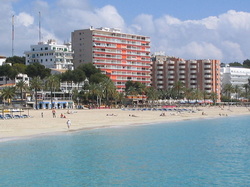Mallorca Travel Guide
One of the world’s most popular holiday destinations, Mallorca is famous for its golden sandy beaches and family-friendly atmosphere. Mallorca is an island of contrasts, from the cliffs and secluded coves of the north coast to the bustling family resorts of the southwest, the rugged and peaceful interior to the cosmopolitan cultural thrills of capital city Palma. At times, Mallorca feels a world away from mainland Spain, an island created purely for relaxation. It’s a view shared by the Spanish Royal Family who holiday at a palace near Palma every summer to enjoy the sunny weather, excellent temperatures and bracing sea air the island has to offer.
History of Mallorca
Mallorca has a long history, with records of habitation going back to the late Stone Age. Some of the island’s main towns, including Palma and Alcudia, were first founded by the Romans and Mallorcan soldiers were a key component of many Roman legions. After the fall of the Roman Empire, Mallorca was invaded by the Vandals before being liberated by the Byzantine general Belisarius in 534. In 902, the island fell to the Moors and remained under Moorish rule until 1230 when it was liberated by King James I of Aragorn. In 1479, the island became a part of Spain with the union of the crowns of Aragon and Castile and played a minor role in Spanish affairs until it functioned as a Nationalist stronghold in the Spanish Civil War in 1936. From the early 1960s, Mallorca underwent rapid development with the advent of mass tourism enabled by cheap air travel and package holidays, becoming the popular tourist destination it is today.
How to Get There
Palma’s airport, Son Sant Joan, is the third largest in Spain and is one of Europe busiest hubs during the summer months. Over 20 million passengers per year pass through Palma airport, with the United Kingdom, Germany and other Spanish cities the most popular destinations. Scheduled services travel from Aberdeen, Belfast, Birmingham, Blackpool, Bournemouth, Cardiff, Doncaster/Sheffield, East Midlands, Edinburgh, Exeter, Glasgow, Leeds-Bradford Liverpool, London (Luton, Standsted, Gatwick), Manchester, Newcastle, Norwich and Southampton throughout the summer with charter services encompassing other airports. Those wishing to drive can take a car ferry from Barcelona or Valencia to Palma.
Climate
Mallorca has a typical Mediterranean climate with long, hot sunny summers and mild but stormy winters. By British standards, the weather is very good indeed. During summer, average temperatures rise to 29.5 degrees Celsius in August while July is the driest month, with just 5mm of rain on average. Average highs in winter are around 15-19 degrees Celsius.
Destinations
Tourism in Mallorca has traditionally been concentrated on the southwest coast, near to Palma and the Calvia municipality, and to a lesser extent in the north, around Alcudia and Porto Pollensa. More recent development, however, has focused on the island’s east coast and opening up its interior to tourists. Palma is the island’s cultural, as well as political, capital with historic cathedrals, an impressive Old Town and stunning architecture. Magaluf and Palma Nova are notorious ’18-30’ destinations focused on clubbing, although local authorities have been working hard to change their image in recent years. Nearby Santa Ponsa is a more family-orientated resort while Alcuida and Porto Pollensa are generally more sedate.
Local Considerations
Mallorca’s main language is Catalan, although Spanish is also an official language. Many locals speak English, however, particularly those who work in the tourist trade. As a part of Spain, Mallorca uses the Euro currency, although a small number of bars, shops and restaurants, especially in Magaluf, accept Sterling. Bureaux de Change are a common feature on most Mallorcan streets, so changing currency is never a problem. The island tends to be much quieter in winter, with some resorts like Santa Ponsa virtually shutting down, so it is best to fully research your destination before departure.



